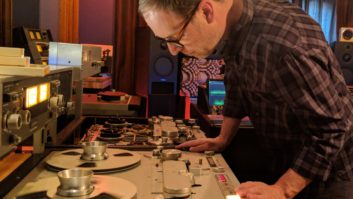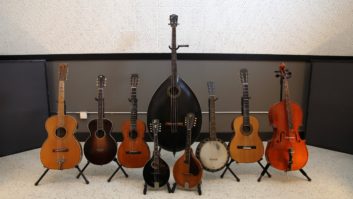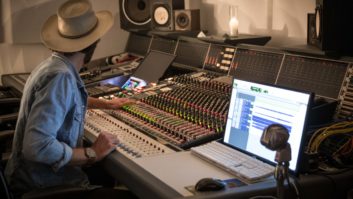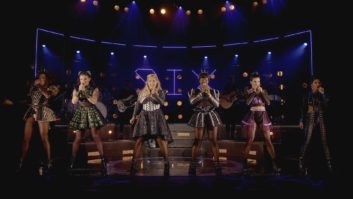Recording engineer Daniel Charles—owner/proprietor of houston, TX’s Sonic Pharmacy recording studio—was honed on punk rock, thus well prepared for a future working with DIY and indie-minded recording artists. Matter of fact, there’s an overall punk aesthetic to Sonic Pharmacy’s recording business, which began in 2007 as a means to “fix bands’ self-recorded tracks,” explains Charles.
Daniel Charles, seated at the one-of-a-kind 32-channel Flickinger 32NB analog mixing console at the heart of Sonic Pharmacy in houston, Tx. “I started with fixing tracks and eventually went with a ‘front-end’ approach to give bands a great start,” he continues. “I’m also a little cheaper than most [competing studios] as I do respect the fact that you have to keep your nose to the ground and budgets matter when releasing your own music. I like to pick and choose whom I work with, too. It’s not the most financially beneficial business model, but it’s what I like to do.”

The biggest challenge of recording indie artists today is that they often expect too much, notes Charles. “They want it to sound like a commercial recording, but there’s only so much you can do when the front end isn’t as good as you hoped. Some say, ‘Our drums don’t sound like their drums,’ yet they’re playing on a $300 kit and comparing it to a $5,000 kit. It’s tough to compete like that. So what we did was buy that $5,000 drum kit—come here and you’ll get the big drum sound. As a struggling artist, you may not have access to that kind of gear, but here, you can get it.”
Charles notes that Sonic Pharmacy provides a variety of instrument amplifiers and even guitars from time to time. “I think it relieves stress in that you can focus on getting the sound you want,” he explains. “The artists will come in with their amps, I’ll check them out, then offer to augment it with one of our amps, too— something completely different but complimentary. When combined, it makes something special. Having everything you need, even instrument-wise, is essential to making a quality and artistic recording.”
The acoustics of Sonic Pharmacy are largely due to its 20-foot by 25-foot main tracking room featuring cork flooring and ceiling surfaces with absorptive material around the walls to minimize reflections. “I really like how guitar amps sound on cork floors,” notes Charles. “Though certain aspects of the studio aren’t ideal, it’s mine, so I’ve had lots of time to learn, for example, exactly where the snare sounds its best.”
Sonic Pharmacy’s centerpiece is its truly unique Flickinger 32NB analog mixing console—the only 32-channel (and thus largest) Flickinger ever made. Its creator, Daniel Flickinger, was a designer/builder of late ’60s/early ’70s premium recording consoles and, most notably, an early innovator of the “sweepable” parametric equalizer and the very first inline console designs. Indie production icon Steve Albini has even been quoted as saying Flickinger consoles “are the best sounding mixing desks ever made.”
“Each Flickinger has its own story,” chuckles Charles, who gained the mixer via the services of Pepper’s Pro Shop, a Nashville-based new, used and vintage gear seller/ broker. “They say Flickingers are cursed, but mine is the lucky one. My 32NB’s schematics were started in 1971. Meanwhile, Daniel Flickinger himself was picked up by the Feds in 1972, which took him to jail, so the console wasn’t finished. As everything in the shop was being seized, someone working for Daniel called United Sound Systems in Detroit, telling them, ‘Here’s a great deal on a Flickinger…but it’s not done yet. We’ll have to build it out at your place.’ So Daniel and his associates smuggled out the 32NB and finished constructing it at United where it stayed until the mid ’80s.”
Incorporating some features that didn’t become popular for nearly a decade after its build—for one, key elements of its EQ design—add to the Flickinger allure. “When you look at it and look at the design, you’ll realize that Daniel Flickinger was a mad genius in 1972,” Charles gushes. “The knobs are all backwards, by the way; you ‘turn it up’ from right to left. Things he discovered by tinkering around were boldly incorporated into the design. Sonically, it has the silky high-end of a Neve, an unmatchable bottom end—I’ve heard nothing else like it—and the punchiness of an API. I’ve read that some say these consoles are muddy and murky; that’s just not the case, at least not with this one. It’s wide open and there’s so much you can do with it, especially thanks to its EQs. Daniel’s EQ design, though it’s probably not the best you can get anymore, could be the most functional. For that reason, it’s hard to make a bad-sounding record with it.”
However, its inherent uniqueness isn’t why Charles bought the Flickinger. “I bought it because it came out of United Sound,” he admits. “I was born in the Detroit area and absorbed that incredible Motown sound. When I found out that this console was available, I jumped at the chance to get it.”
In building out Sonic Pharmacy’s impressive outboard gear list, Charles works to find pieces with unmistakable and striking character. “I tend to collect the ‘one-trick ponies’ of the processing world, not the workhorses or tools that work on a wide range of applications,” he explains. “I’d rather consider a piece of gear for potential use on, say, every third record; when I need it, it’s there and it lends a notable difference. I also tend to buy tube gear, too; transformers with tubes lend that characteristic everyone seems to agree is pleasing to the ear.”
Buying, trying and selling gear has been a proven method in building his studio’s sound, tells Charles. “I’ve gone through a lot of gear to get to where I am now. I’ll usually buy a piece of gear, use it for a year, and if I haven’t really used it much, I’ll sell it and get something else.”
Select gear from the Sonic Pharmacy equipment list includes Tree Audio’s The Roots console (primarily for its preamps) and Ingram Engineering MP685 preamps; EQs by Kush Audio, Inward Connections, Mercury Audio and Tube-Tech; compressor/limiters by Acme Audio, Dangerous Music, EMI, Gates, Purple Audio, RCA, Retro Instruments and Universal Audio, plus the “Faircharles 670,” a Fairchild clone hand-built by Charles himself to original spec with NOS tubes and original transformers. Charles also relies on JBL 3 series studio monitors (a LSR308 pair), SSL Alpha Link converters modded by Black Lion Audio, and a bevy of AKG, AEA, Blue, Cathedral Pipes, Electro-Voice, Royer and Shure microphones.
Charles is particularly enthusiastic about his latest discovery, Miktek microphones, which he says “stack up well against the best mics made. Compression-wise, I especially like the Retro Instruments 176 and my two Gates Sta-Levels—I’ll use those every time, on every single record. I also like my four LA-3As. We tinker and listen, always shootout gear and forget the rules. That’s why my mixing sessions last longer than most, I guess, but we’re trying to push the limits and come up with something new every time.”
Sonic Pharmacy
sonicpharmacy.com







